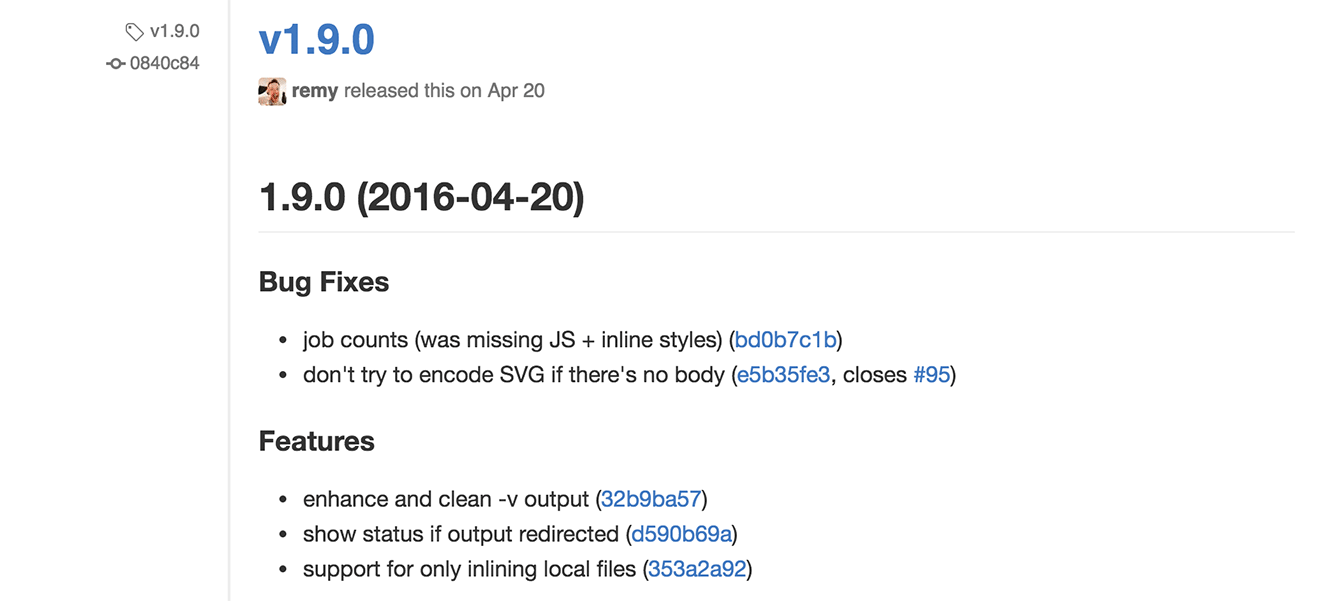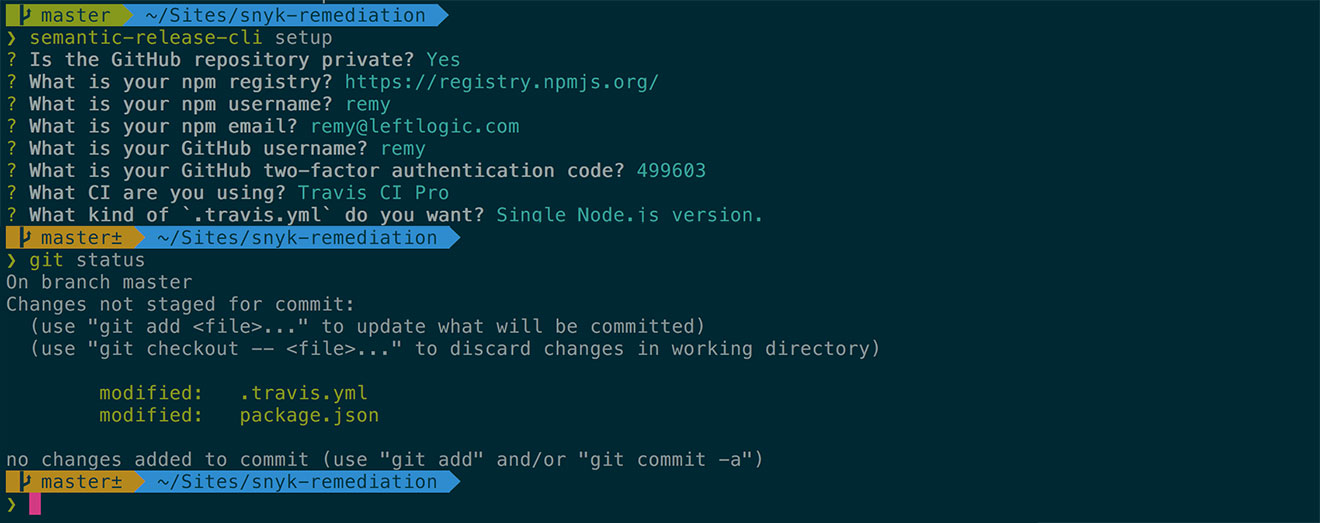When I originally created this post I was working on a project where I kept running into the constraints of versioning a package that I was pushing to npm. I'll explain the problem, but now I have a near perfect workflow that completely mitigates the entire issue of versioning.
Background
I have a (node based) project that I want to publish to npm, and I want to follow semver for versioning.
That's fine, I know when I'm adding features (minor) and fixes (patched) and I rarely, if ever, commit breaking changes (major).
In the last year, I've moved to standardised structure for commit messages (instead of whatever I fancy). I'm using the Angular commit style (though I don't write any Angular code) which prefixes with fix: or feature: and subjects are limited to 50 characters with more detail in the body.
The commit history now, to me, looks so clear and so much easier to scan through. Then I run npm version patch which creates a new commit and a new tag. Finally, I is push changes and tags to GitHub and push to npm.
There's two problems with this process. The first is aesthetic. The history contains the version anomaly that just doesn't quite look right, and when we look at that tag on the project, it only ever contains the single commit that changed the package version:

The second is much more serious: what if I distribute a compiled (either minified or transpiled) copy of the code and I want the version string to appear in the build?
To reiterate, the workflow is:
- fix: removed that bug
- feat: added that awesome thing
- chore: do some stuff
- chore: generate build ⬅ the version here is 3.35.8
- 3.36.0
The tagged build of version 3.36.0 now has a version string inside of it that says 3.35.8. This is wrong, and indeed bad.
Chicken and egg
In the situation I describe above, I need to include the version in the build otherwise I can't debug what other people are seeing (and can't narrow down to a specific version of code). One alternative would be to build after the tag, and deploy the package, but now if I look at the git history, the version tag is the commit before the distribution build.
I did write a postversion script that went through a insane amount of backtracking and git juggling to revert commits and rewrite them. It doesn't scale well, and frankly it's brittle as hell. All of these individual steps were triggered on the post version life cycle:
# build the dist output using babel
npm run build &&
# then add it to git
git add dist/* &&
# amend the last commit(!!!) inline and use the version as the commit
git commit --amend -m"$npm_package_version" &&
# delete the old tag(!!!)
git tag -d v$npm_package_version &&
# then re-tag :-\
git tag -a v$npm_package_version -m "chore: release $npm_package_version"
What a total mess. Originally this post was going to stop here. What on earth do you do? How do other developers get around this issue, if at all?
But then thanks to Stephan Bönnemann (the Author), Semantic Release found its way into my development life ❤
Versioning solution: Semantic Release
Semantic release is a tool that will read your commits and do the following automatically for me if there's a fix or feature:
- Work out the next semver version, and push that to npm
- Add a new release to GitHub and include full release notes (pointing to commits and related issues from the commits)
This is huge, because I don't need to worry about versioning myself (which if I'm honest, could be occasionally missed), it builds that ever illusive changelog and there's no nasty v1.0.4 commits in my history.
One huge benefit to me is that semantic release will generate and publish the release notes automatically for me in GitHub.
The process has evolved over time so if you've heard of it and had a bad experience, bear with me.
You want to use the CLI tool when setting up your projects each time. You can't just copy and paste the changes to each project because the CLI tool is also configuring Travis with specific environment values that allow Semantic Release to read your git commit history and also ensure that the final publish step to npm is under your account.
To get started install the CLI and run it in your project directory and answer the questions:
$ npm install --global semantic-release-cli
Gotcha: I'm sure will be fixed eventually, semantic release will overwrite your .travis.yml file, so I always make sure to manually edit and resolve the changes by hand.
Fixing the distribution problem
The crux of how semantic release works is that there's a life cycle that runs the preconditions, then executes the user code (unusually just npm publish ) then runs the post release process (adding changelog and tags to GitHub).
Semantic release does have a plugin architecture so you can add your own preconditions, but what interests me is the middle step, the "let's do this" part.
Here is where I can run the build process and generate the dist directory. Since the npm publish step takes everything in the directory, the distribution files will be included in the npm release - and in fact don't even have to live in GitHub (which IMHO is ideal).
Gotcha: I got caught out by this recently: I ignore the dist directory in my .gitignore file so it stays out of git. That's good. Except that npm publish also uses the git ignore file if there's no .npmignore file present. So I need to either make an empty .npmignore file (which is a workaround) or put !dist explicitly in the .npmignore and this ensures the distribution directory is included in the npm release.
Will this create a release for every change I commit?
Good question (if I do say so myself). It depends entirely on your release workflow.
If you're committing directly into master and pushing every individual commit to GitHub, then yes, you'll get a release for every fix and feature.
However, as soon as you stop pushing every commit, semantic release will bundle together all your commits since the last release, and calculate the correct version change and generate change log (which god knows is a PITA to manage yourself). You can see this in some of my inliner releases:

This is then amplified when you're working off a develop (for instance) branch and merging a group of changes at once (the type of GitFlow workflow).
It's also worth remembering that by default semantic release is only running on master, and comparing to your last release in npm.
"But what if I want to show the version?"
One question I got stuck on early on was being able to echo out the version number (since I write a lot of CLI tools). I would rely on the package.json to hold the version, and with a semantic release set up, you don't have a version property in the package.
So, as it turns out, this isn't an issue at all. It only affects me during development. Once the users of my CLI tool have installed, they have the copy that does have the version property (as semantic release adds it right before the npm publish step).
I've worked around this problem (that only affects the development copy) using my own version promise code which I use in a number of CLI tools now.
A brief walk through
I've added semantic release to both new projects and existing projects, and I find the process fairly painless. First though, you want the set up tool (that I mentioned earlier:
npm install -g semantic-release-cli
Then from your project directory (assuming it has a package.json), run semantic-release-cli setup and answer the questions:

In this particular case, I had a private project run on Travis Pro, but for many of my projects I'll be using public repos and regular Travis. This process will update package.json and .travis.yml. Semantic release also sets two private environment values in Travis: your npm token and a newly created personal Github token. This is all it needs to manage the process of setting new versions and pushing to npm.
Now I'll commit the changes semantic release made, and push to Github. Travis will automatically receive the project (setup by semantic release) and if the tests pass, semantic release will work out the new version number, add it to package.json inside Travis and push all the local code as a new npm release.
Pretty neat.
Other concerns
There's a couple of extra notes I wanted to share: firstly if you're maintaining "maintenance releases" (ie. previous major versions), you can do this, but you need to follow specific directions.
Then also you can use semantic release to do some funkier stuff. For instance, I use it to deploy this static blog! But how I do that, is for another post, another day 😉